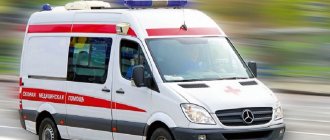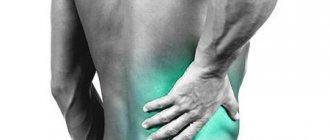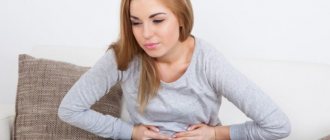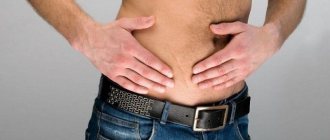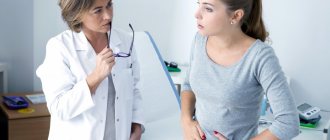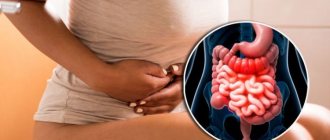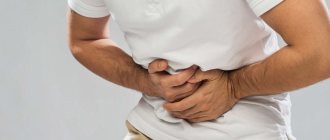Determining the cause of pain by symptoms
The table was compiled by Victoria Druzhikina, a practicing therapist on the AskVracha website, and serves as the most reliable source of information when determining the cause of pain.
| Disease | Symptom | Drugs used |
| Acute cholecystitis | Acute, severe pain radiating downwards, nausea, vomiting, fever, loose stools. | Antispasmodics (Duspatalin, No-shpa, Papaverine); Antibiotics (Ciprofloxacin, Amikacin, Meropenem); Analgesics (Diclofenac, Ketorol); Antacids (Famotidine, Omeprazole, Rabeprazole). |
| Chronic cholecystitis | Most often dull, aching, paroxysmal pain, intensifying after fatty foods, rarely - pronounced, loose stools. | Antispasmodics (“Duspatalin”, “No-shpa”, “Papaverine”); Antibiotics (“Ciprofloxacin”, “Amikacin”, “Meropenem”); Analgesics (“Diclofenac”, “Ketorol”); Antacids (Famotidine, Omeprazole, Rabeprazole). |
| ZhKB | Sharp, cutting pain, nausea, vomiting, yellowing of the skin, loose stools" | Antispasmodics (“Duspatalin”, “No-shpa”, “Papaverine”); Antibiotics (“Ciprofloxacin”, “Amikacin”, “Meropenem”); Analgesics (“Diclofenac”, “Ketorol”); Antacids (Famotidine, Omeprazole, Rabeprazole), surgery |
| Hepatitis | The pain is strong, but dull, and may be nagging. Nausea, vomiting, fever, loose stools, weakness, sweating. | Specific antiviral therapy. |
| Cirrhosis of the liver | Dull, in the final stage severe pain, ascites (fluid in the abdominal cavity, looks like a bulging belly), yellow-brown tongue, weakness, nausea, vomiting, loose stools, heaviness in the right side. The protruding edge of the liver is often visible from under the ribs. In the final stage, the organ shrinks and stops protruding. | Hepatoprotectors (“Heptral”, “Ursosan”, “Ornithi”n, milk thistle extract); Proton pump inhibitors (Omeprazole, Rabeprazole, Esomeprazole); Anticholinergic drugs (Mebeverine, Trimebutine). |
| Appendicitis | Many faces - pains are sharp, dull, strong, weak, from the navel to the level of the sternum. Nausea, single vomiting. Fever. Loose stools. Mixing of pain from the epigastrium to the right iliac region after 3–4 hours from the onset (Kocher’s symptom). | Surgery |
| Enteritis, colitis | Pain along the intestines, rumbling in the abdomen, bloating, blood and mucus in the stool. The stool is irregular, liquid. | Antispasmodics (“No-shpa”, “Papaverine”); Antidiarrheal ("Smecta") |
| Bowel cancer | The pain is aching at first, then severe. Constipation, obstruction, weight loss. | Surgical treatment, chemotherapy, radiation |
| Nephroptosis | The pain is often associated with sudden movements, especially high jumps. Varying intensity, usually medium. | Kinesiology. Osteopathy. Surgical correction – kidney suturing |
| Osteochondrosis | The pain comes from the spine and intensifies with movement, inhalation, and coughing. At rest I subside or decrease. | NSAIDs (“Meloxicam”, “Xefocam”, “Diclofenac”, “Aertal”); Muscle relaxants (“Sirdalud”, “Mydocalm”); Chondroprotectors (“Teraflex”, “Dona”, “Arthra”); B vitamins (“Neurobion”, “Combilipen”, “Milgamma”). |
| Endometriosis | The pain is quite intense and is accompanied by cycle disruption and bleeding. | Surgery; Hormonal drugs. |
| Bruise, injury | Pain is associated with a fall, blow, etc., and is limited by this impact. Intensifies with pressure. Accompanied by the formation of a hematoma and bruise. | NSAIDs (Meloxicam, Xefocam, Diclofenac). |
| Myositis | Pain in the muscle, intensifies with pressure and movement. Quite noticeable, subsides when resting. | NSAIDs (“Meloxicam”, “Xefocam”, “Diclofenac”, “Aertal”); Muscle relaxants (“Sirdalud”, “Mydocalm”); |
Pain during pregnancy
In the first trimester, the uterus grows, the ligaments that attach it to the pelvic cavity stretch. These natural changes in a woman’s body during pregnancy are accompanied by mild pain. It should not cause concern either in the first trimester or in the last, when such sensations become harbingers of first training and then labor contractions. Worse, if bleeding occurs at the same time, then these are signs of the following conditions:
- Risk of miscarriage.
- Premature detachment of the chorion or placenta.
- Ectopic pregnancy.
Pain with bleeding after intercourse is a sign of cervicitis or cervical erosion.
Unhealthy sensations in the abdomen also occur during rough obstetric examinations, after which the uterus becomes excitable and tones. This state of the organ is determined by palpation or an ultrasound sensor, and is also indicated by pain during vaginal examination.
Hypertonicity
In emotionally unstable pregnant women, closer to childbirth, a condition called the pathological preliminary period occurs. The symptom of hypertonicity does not lead to labor, but is very exhausting. This is a periodically recurring cramping pain in the lower abdomen and lower back (severe and does not go away for a long time). Torment that lasts 6, 24 or 48 hours often ends in complications:
- Earlier outpouring of water.
- Weakness of labor.
- Fetal hypoxia.
Pain during pregnancy is dangerous when a squeezing lump is felt inside, as well as in the following cases:
- It is pulling, cramping or aching.
- Occurs in the evening, during rest, after light physical activity.
Lesions and gallbladder
The liver and gallbladder are critically important internal human organs. Even the slightest disruption to their work can lead to serious consequences. Regular nagging pain in the right side at waist level may indicate that a pathology of these organs is developing.
Cholecystitis (Inflammatory process in the gallbladder)
It is usually a natural complication of developed gallstone disease and is associated with a disruption of the organ’s ecosystem. In most cases, cholecystitis develops in the presence of stones in the gall bladder. The inflammatory process develops rapidly in the acute form and relatively sluggishly in the chronic form.
Treatment of cholecystitis against the background of cholelithiasis is carried out by a surgeon, without cholelithiasis - by a therapist or gastroenterologist.
In the photo: the formation of stones in the gall bladder
Cholelithiasis
Mineralization processes in the gallbladder lead to the appearance of stones and inflammation. Organ tissues turn yellow
If the formed stones block the free flow of bile, then acute pain appears in the side. If the condition worsens, you must call an ambulance.
There is a wide range of drugs available for drug therapy. These include ursodeoxycholic acid (UDCA) and its generics. In cases where the outlet for bile is blocked, the stone has gone into the duct, surgical intervention is performed to remove the stones. A surgeon treats diseases.
Hepatitis
Hepatitis A, B and C are infectious acute diseases that can lead to significant problems and subsequent complications. Often, pain in the right side is a potential symptom of the disease.
In addition to pain, fever, weakness, aching joints, and an increase in the size and weight of the spleen and liver are possible. For conservative treatment use:
- for hepatitis C, direct-acting antiviral drugs;
- for hepatitis B nucleotides/nucleosides;
- for A and B – vaccination;
- it is possible to use vitamin complexes and hepatoprotectors.
If the symptoms are similar, a general practitioner will be able to identify the disease and prescribe therapy.
Cirrhosis of the liver
Any pain at the waist level should be taken seriously. At waist level are the major vital organs, including the liver. Rapid acute intoxication of the organ and prolonged exposure to toxins can lead to tissue destruction and cirrhosis.
The disease quickly becomes chronic and the damage becomes irreversible. Therapy comes down to maintaining the function of the organ using all possible medications. If you suspect liver pathology, you can consult a hepatologist.
What to do if there is pain in the right side
For pain in the side, if the doctor cannot “by eye” determine the cause of the ailment, he sends the patient for an ultrasound of the abdominal cavity, ultrasound of the kidneys or ultrasound of the pelvis. Ultrasound waves with a frequency of over 20,000 Hz penetrate the skin into the abdominal cavity, where they are either absorbed by internal organs or reflected back. Special sensors (with abdominal ultrasound) analyze the reflected sound, and based on it, conclusions are drawn about the patient’s condition.
- When tissues become inflamed, they soften and absorb ultrasound more than healthy areas.
- Various lumps, tumors, and stones reflect radiation better, and it can be reliably stated that the cause of the pain is a stone or neoplasm.
- Doppler ultrasound allows you to evaluate the speed of blood flow to exclude compression of the inferior vena cava.
Gastrointestinal pathologies
The main parts of the gastrointestinal tract system are located in the abdominal cavity, and therefore they often become the cause of pain syndromes
Inflammation of the appendix (Appendicitis)
In scientific circles, appendicitis is an inflammatory process with a focus in the appendix with the accumulation of pus inside the appendix at the narrowed bottom. This can not only cause pain in the right side at the waist level, but also many other unpleasant symptoms.
The disease develops rapidly, and acute forms are fraught with fatal outcomes. Localization of pain in the right side or bottom is sometimes caused by pylephlebitis (this is an inflammatory process involving the portal vein, which leads to direct damage to the liver).
A consultation with a surgeon will help confirm suspicions of appendicitis.
Intestinal inflammation
Disruption of the microflora, bacterial and viral invasions, as well as the entry of foreign objects into the intestines provoke inflammation. The disease is accompanied by defecation disorders, the appearance of stool mixed with mucus or blood, flatulence and pain of various types.
For treatment, if necessary, antibiotics of different groups are used, depending on the disease (Enterofuril, Oleandomycin, Amoxicillin, etc.).
Oncological diseases of the intestine
Nowadays, cancer is detected quite early. Colonoscopy and MRI can identify suspicious clusters of cells and quickly reveal their nature. If you notice symptoms (pain, change in color of stool, defecation disorders), you should immediately consult a doctor.
The therapeutic plan is developed depending on the stage of the cancer. It is possible to use chemotherapy or surgical removal of malignant tissue. Read about polyps in the intestines here.
Treatment
Help before diagnosis
Mild pain in the right side associated with hypothermia or physical activity does not require drug treatment. Mostly they go away on their own after 1-3 days. If the pain syndrome bothers you for a long time or the intensity of the pain increases quickly, you should immediately seek medical help. For excruciating pain, the doctor uses analgesics at the prehospital stage.
Conservative therapy
To relieve pain, nonsteroidal anti-inflammatory drugs, narcotic analgesics, and antispasmodics are used in practical medicine. For quick pain relief, blockades are made with local anesthetics. These measures provide a temporary effect, so subsequently, to eliminate pain in the right side, etiotropic therapy is prescribed that affects the underlying disease. The following groups of medications are used in surgery and gastroenterology:
- Anti-inflammatory drugs.
Inflammation is controlled not only by classic NSAIDs, but also by 5-aminosalicylic acid derivatives and corticosteroid hormones. - Probiotics.
Medicines are needed to restore microflora and normal intestinal function, which helps reduce pain and eliminate dyspeptic disorders. - Infusion solutions.
Necessary for correcting dehydration of the body, removing toxic breakdown products from the blood, maintaining normal hemodynamic parameters. - Antibiotics.
The drugs are prescribed for generalized forms of salmonellosis, for the prevention of purulent complications of inflammatory diseases of the digestive organs. - Cytostatics.
Taken for severe forms of Crohn's disease when hormonal therapy is ineffective. They are also included in chemotherapy regimens used for malignant neoplasia of the colon.
To improve the patient's condition, symptomatic therapy is carried out. Antidiarrheal or laxative drugs, drugs with pancreatic enzymes, and prokinetics are selected. In order to correct metabolic processes, vitamin and mineral complexes containing iron are indicated. During the recovery period of chronic diseases, courses of physiotherapy, drinking mineral waters, and sanatorium-resort treatment are recommended.
Surgery
Urgent surgical intervention is performed for acute appendicitis (laparoscopic or classic appendectomy), strangulated hernia (revision of abdominal organs and hernioplasty). When fistulas and abscesses form in those suffering from Crohn's disease, their opening and sanitation is indicated. If total damage to all layers of the intestinal wall develops, the operation of choice is resection of the intestinal section.
If an ectopic pregnancy is interrupted, urgent surgical care is required. The type of operation is selected taking into account the severity of complications and the woman’s desire to have children in the future. An organ-sparing tubotomy or radical tubectomy is performed. When an ovarian cyst ruptures, a wedge resection or oophorectomy is performed. Some forms of endometriosis require elective surgical treatment.
Diseases of the spine and kidneys
Painful sensations are not always associated with problems with the liver or gastrointestinal tract. Problems with the spine and osteochondrosis often cause similar symptoms. A neurologist treats osteochondrosis.
Nephroptosis
Nephropotosis – prolapse of the kidney. Mobile kidney syndrome is often accompanied by pain at the waist level.
The disease is divided into three levels (degrees). Nephroptosis appears on the right side more often, and also becomes obvious in the second stage, when the kidney is easily palpable through the skin at waist level in non-obese patients.
Pain in the right side may be an early symptom of the development of level 1 nephroptosis, and therefore pain should not be ignored. Various techniques are used for diagnosis:
- Carrying out complete blood biochemistry;
- Study of the state of biological fluids;
- Ultrasound scan at waist level;
- X-ray scanning.
Conservative forms of treatment: wearing a special corrective bandage at the level of the waist or lower abdominal area, exercise therapy and exercises. Surgery is rarely prescribed. The treatment of kidney diseases in women is described here.
Osteochondrosis and hernia
Discomfort and pain are often associated with nerve compression or inflammation of the skeletal muscles. A characteristic symptom is loss of flexibility, as well as increased discomfort with sudden movements or even breathing.
To relieve some symptoms, medications are prescribed to reduce inflammation, as well as exercise therapy and physiotherapy. Find out about the symptoms of hernia in men from this article.
Doctor's advice
Shingles. The pain of herpes zoster before the appearance of characteristic rashes in the form of blisters along the nerve can be so severe that they are mistaken for a heart attack or renal colic. Having excluded all conditions using examination, laboratory (general and biochemical blood tests, general urine analysis) and instrumental (ECG, ultrasound, MRI) research methods, herpes can be assumed.
Victoria Druzhikina Neurologist, Therapist
Pinched nerve
Pain around the navel
In men, pain occurs for the following reasons:
- Chronic prostatitis.
- Diverticulosis.
- Difficulty urinating.
- Megacolon (if a congenital malformation is the immaturity of the innovative apparatus of the colon, acquired - the presence of a tumor or scar narrowing).
Causes in children:
- Rapid or defective development of the gastrointestinal tract.
- Intestinal volvulus.
- Indigestion (colic occurs).
- Helminthic infestation, when there are many parasites.
In women, pain is caused by diseases of the reproductive organs or urinary system:
- Endometriosis.
- Cystitis.
- Inflammation in the pelvic region.
- Fibroids or uterine cancer.
Pain in the lower abdomen in women
The lower abdomen may hurt for the same reasons as the side. Pain in the right side of the lower abdomen in women is often a manifestation of the following pathologies: inflammation of the uterine appendages, less often – ovarian cysts and the primary stages of uterine fibroids. The lower abdomen is the main part of the abdominal cavity, but pain can be caused by pathologies of surrounding organs and tissues. Very often, the lower abdomen hurts due to complications of pathologies of the reproductive organs. What are the causes of discomfort in the lower abdomen?
Endometriosis
This is a common disease that often develops in healthy women and mainly affects people of reproductive age. The endometrial tissue (uterine wall) begins to grow and spread into the surrounding tissue. This causes pain in the lower abdomen.
There are two main types of endometriosis: Genital. In this case, endometrial cells are localized in the uterus and ovaries. Extragenital. In this situation, the growth can affect the entire lower abdomen, and the inflammatory process affects the intestines and navel. Based on the nature and severity of the disease, the disease is divided into 4 degrees. Laparoscopy is recognized as the only effective diagnostic method. This is an “exploratory” surgical operation that is performed through an opening in the lower abdominal cavity.
Treatment is with hormonal drugs, painkillers and anti-inflammatory drugs. In some cases, surgical intervention is necessary. If the right side of the lower abdomen hurts in women, this is very often a manifestation of complications in the reproductive system. Other possible causes of lower abdominal pain are described here. If you have similar symptoms, you can see a gynecologist online.
What can hurt in the stomach on the right?
The causes of pain under the right rib can also be diseases in various organs:
- Liver diseases
: hepatitis (inflammation), hepatosis (metabolic disorders), cirrhosis (replacement of parenchymal cells with connective tissue), liver parasites, metastases as a result of malignant tumors of other organs. - Heart diseases
(they cause circulatory disorders): myocarditis, endocarditis, coronary heart disease, abdominal myocardial infarction. - Gallbladder diseases
: cholecystitis (inflammation), cancerous tumors. - Intestinal diseases: colitis (inflammation of the mucous membrane of the large intestine), Crohn's disease (severe damage to the entire gastrointestinal tract from the throat to the anus), diarrhea, diverticulosis (protrusion of the intestinal mucosa through the muscle wall), irritable bowel syndrome, intestinal infections.
- Diseases of the right kidney
: abscess (purulent inflammation), pyelonephritis (bacterial inflammation), cysts, kidney stones, echinococcosis (presence of helminths in the kidney), tuberculosis (drying) of the kidney, malignant tumor. - Diaphragmatitis (inflammation of the pleura covering the diaphragm).
- Adrenal tumors.
- Intercostal neuralgia (irritation of the intercostal nerves).
- Formation of blood clots in the inferior vena cava.
Diagnostic methods
| Cause of pain in right side | Diagnostic methods |
| Liver diseases | OAM, OAC, Blood biochemistry, CT, MRI, ultrasound. |
| Appendicitis | CBC with leukocyte formula, OAM, ultrasound |
| Nephroptosis and kidney disease | OAM, UAC, Blood biochemistry, CT, ultrasound. |
| Diseases of the female reproductive system | OAM, OBC, Blood biochemistry, CT, MRI, Ultrasound, Laparoscopy. |
| Bruises and injuries | Visual examination, history, palpation. |
| Diseases of the gastrointestinal tract | OAM, OBC, Blood biochemistry, CT, MRI, Ultrasound, Colonoscopy, |
Causes of pain in the right hypochondrium
Pain in the right side of the abdomen does not always indicate any disease. At times they are caused by physiological changes that also happen to completely healthy people.
- Stitches in the side after jogging
or other physical activity. This is typical for unprepared people who are not used to playing sports. Physical activity is stressful for their body, and it reacts with a sharp release of adrenaline. The hormone provokes a spasm of the bile ducts, which stretch from the bile overflowing them. At the same time, the liver fills with blood, increases in size, and the organs press on each other, causing pinpoint pain and tingling. - Tingling in the right side
after a heavy meal. On a full stomach you don’t want to move or move. Under the influence of adrenaline, the inferior vena cava expands and puts pressure on the liver, which is also under pressure from a full stomach. This is why you should not exercise immediately after eating. - Sharp pain in the right side
, radiating to the back. This happens in women shortly before the start of menstruation. Hormonal imbalance causes spasm of the bile ducts, resulting in sharp pain that radiates to the back. It goes away on its own, but causes significant discomfort to the woman. - Pain in the right side during pregnancy
. The uterus, stretched under the influence of the growing fetus, puts pressure on neighboring organs. Also, the hormone progesterone, secreted to relax smooth muscles and prevent miscarriage, provokes stagnation of bile (cholestasis in pregnant women). Many pregnant women experience pain in the right hypochondrium, which intensifies with movement. Therefore, women need to limit their loads and walk more at a slow pace. - Cramps in the lower abdomen (not menstrual)
. Hepatic, renal, and intestinal colic are characterized by irradiation—reflection of the pain signal to another part of the body.
Frequently asked questions and doctor's answer
General practitioner Victoria Druzhikina answered questions
Pain in the right side at the level of the lateral ribs - “The most common options for such symptoms are pancreatitis, cholecystitis, osteochondrosis, cholelithiasis, hepatitis. Everything except osteochondrosis can be diagnosed using ultrasound of the abdominal organs. Problems with the spine are confirmed using an MRI or x-ray of the area concerned.”
Pain in the right side from the back - “Pain radiates to the back with the following diseases: pancreatitis, pyelonephritis, osteochondrosis, cholelithiasis, pancreatic cancer, ulcer. Damage to the pancreas is characterized by girdle pain.”
Pain in the right side at the waist level in front in women - “Inflammatory bowel diseases, endometriosis, myositis manifest themselves with just such symptoms. With intestinal pathology, the stool will be disturbed - liquid, frequent, with admixtures of mucus or blood. Endometriosis is accompanied by bleeding and cycle disruption. Myositis occurs only with local symptoms. For pain in women, consultation with a gynecologist is indicated.”
Pain in the right side at the waist level in front in men - “With such pain, one can suspect osteochondrosis, inflammatory bowel disease, myositis. Examination and palpation give a lot - a tense, painful muscle with myositis, a rumbling painful stomach, limited mobility of the spine due to pain with osteochondrosis will help to suggest a pathology and refer for further examination (ultrasound of the kidneys, X-ray or MRI of the spine, general blood and urine tests, stool analysis and etc.)."
Pain in the right side under the ribs radiates to the back - “Symptoms can be observed with osteochondrosis, pancreatitis, cholecystitis, cholelithiasis. All conditions require medical evaluation and care. Hospitalization may be indicated."
Differences in men and women: diseases by gender type - “The cause of pain in the right side differs depending on gender. Women may have pathologies of the reproductive system - endometriosis, inflammation of the ovaries or their appendages. Men are more likely to have liver problems and osteochondrosis.”
Reproductive diseases
They are, of course, different for men and women. For representatives of the fair sex, an unexpected painful sensation in the waist area can be quite physiological and indicate ovulation. Also, pain in the abdominal area is common during menstruation due to active uterine contractions or during hormonal changes in the body.
Thus, an unpleasant syndrome often occurs in pregnant women. Pain on the right side in pregnant women is a common occurrence. It is usually associated with displacement of organs due to fetal growth and is physiological in nature.
But if the pain is severe, or is accompanied by additional alarming signs, you should definitely see a doctor. Sometimes painful syndromes in the waist area on the right in representatives of both the weaker and stronger sex are pathological in nature and suggest the following diseases:
| Among women | Essential medicines | In men | Essential medicines |
| Acute adnexitis | Antibacterial drugs of different groups, for example, aminoglycosides and penicillins (“Oxacillin” and “Kanamycin”) | Colliculitis | Instillation of the urethra with antiseptic solutions and the use of antibiotic drugs depending on the type of infection |
| Ovarian cyst | Hormonal drugs, for example, Rigevidon, Marvelon, Diane-35 | Orchitis | Drugs to eliminate pain, swelling and inflammation (Diclofenac, Ibuprofen), for bacterial causes of the disease - antibiotics (Amoxicillin, Amoxiclav, Erythromycin, Azithromycin) |
| Ovarian rupture | For minor tears, antispasmodics will help. The same “No-spa” and bed rest, the rupture requires laparoscopic surgery | Orchiepididymitis | Drugs to eliminate pain, swelling and inflammation (Diclofenac, Ibuprofen), for bacterial causes of the disease - antibiotics (Amoxicillin, Amoxiclav, Erythromycin, Azithromycin) |
| Malignant neoplasms | Surgery and chemotherapy will be required | Prostatitis | Antibiotics (“Oxacillin”, “Sulfa-P”), as well as means for relieving unpleasant symptoms and recovery (“Prostatilen”, “Prostan”, “Vitaprost”, “Prostamol Uno”) |
If a woman has discomfort that lasts more than two days and is not related to menstruation, she should definitely visit a gynecologist. And if pain torments a representative of the stronger sex, you need to go to the doctor as soon as possible. Self-medication is impossible here; a course of treatment must be prescribed by a doctor. Otherwise, there is a risk of losing the ability to have offspring and the degeneration of illnesses into severe forms.
When to see a doctor
Pain at the waist or lower abdominal region indicates the development of hidden pathologies affecting various internal organs (in the absence of injuries or bruises), and therefore, when this symptom appears, it is necessary to visit a doctor for an initial examination and diagnostic measures. The waist level is the location of vital organs and tissues that are vulnerable to a wide range of infectious, bacterial and genetic diseases. Even after an ordinary injury, if you have abdominal pain at the waist level, it is better to go to the doctor for a consultation.
Visit a doctor at the first symptoms. Pain in the side at waist level should absolutely not be ignored. This is an alarm bell that should immediately make you “scurry around” and get ready to go to the hospital. Never put off visiting a doctor. Timely detection of the disease is the key to recovery.
This article has been verified by a current qualified physician, Victoria Druzhikina, and can be considered a reliable source of information for site users.
Rate how helpful this article was
4.4 55 people voted, average rating 4.4
Did you like the article? Save it to your wall so you don’t lose it!
How to relieve pain at home
- If you experience abdominal pain on the right side for the first time, you should not take analgesics on your own. Anesthesia may distort the clinical picture and make diagnosis difficult.
- If there are signs of an “acute abdomen” (pain, board-shaped abdomen, vomiting, stool retention, fever), cold (a heating pad with ice on the epicenter of pain), hunger, rest (the patient should be placed in a comfortable position) and calling emergency help are recommended.
- If the patient cannot wait until the ambulance arrives, it is permissible to give an antispasmodic tablet.
